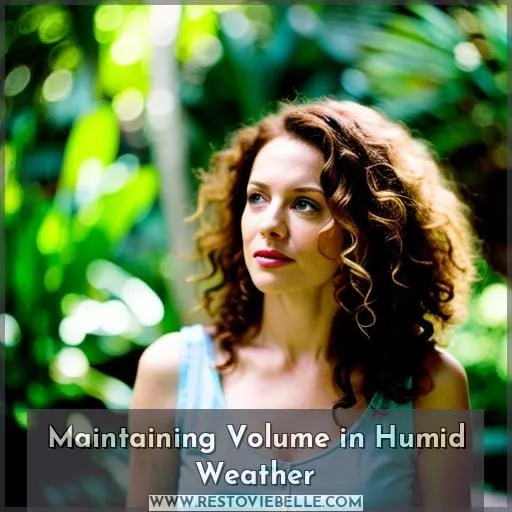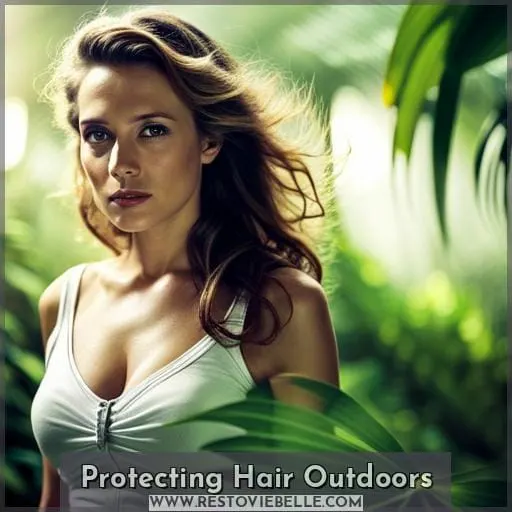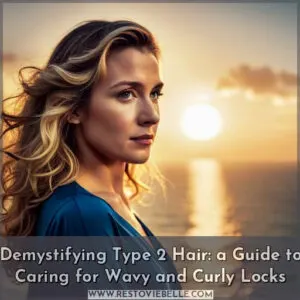This site is supported by our readers. We may earn a commission, at no cost to you, if you purchase through links.
 Feel like humidity wrecks your hair no matter what you do? If you have low porosity hair, the moisture in humid air can really cause mayhem.
Feel like humidity wrecks your hair no matter what you do? If you have low porosity hair, the moisture in humid air can really cause mayhem.
It’s because humidity creates weak bonds between water molecules and your hair strands, messing with your hair’s structure. While you can’t change your hair porosity, you can care for your low porosity hair in ways that limit the humidity havoc.
The key is locking in moisture and keeping your hair cuticles sealed. With the right products and techniques, you can maintain hydration, fight frizz and flatness, and achieve the beautiful hairstyles you desire – even when it’s muggy out.
Don’t let humidity get you down. With expertise and understanding, you can gain freedom over the frizzy, flat hair days humidity often brings.
Table Of Contents
Key Takeaways
- Humidity weakens the hydrogen bonds in hair proteins, opening the cuticles and allowing excess moisture to penetrate the strands.
- This causes low porosity hair to become flattened and lose volume as it gets heavier.
- The moisture imbalance leads to simultaneous frizz and dryness in the hair.
- Lightweight leave-ins, sealing oils, volumizers, and protective hairstyles can all help combat the effects of humidity on low porosity hair.
What is Low Porosity Hair?
You feel the smoothness of your hair strands resisting the moisture in the air like a duck’s feathers shedding water.
Low porosity hair has a tightly bound cuticle layer that makes it difficult for moisture to penetrate the hair shaft. This hair type is genetically predisposed to have a dense, compact cuticle structure that does not allow easy passage of water or oils.
The characteristics of low porosity hair include taking longer to get wet, resisting moisture absorption, and having a hard time holding onto conditioning products. To care for your low porosity hair, use lightweight leave-in conditioners and oils to coat the strands.
Look for products labeled as moisturizing or containing humectants to draw in hydration through the cuticle.
While genetics plays a key role in determining your low porosity hair type, hair damage from chemicals and heat styling can also influence your hair’s porosity level. Understanding your hair’s characteristics is the first step to creating an optimal care regimen.
How Humidity Impacts Low Porosity Hair
Flatness and heaviness are two words that summarize the effects humidity can have on low porosity hair. When the humidity is high, the extra moisture in the air sits on the surface of the strands. This adds weight to the hair, causing it to fall flat. The excess moisture simply rests on the cuticle rather than penetrating the hair shaft, resulting in limp locks lacking volume.
To revive hair weighed down by humidity, try using a clarifying shampoo to remove buildup and lighten the load. Follow with a volumizing conditioner and mousse before drying and styling as usual. Switching to lightweight products free of heavy oils or butters can also help create lift.
For some, a blowout with a round brush delivers the volume and movement that humidity stole. Staying away from humectant-rich products when the forecast calls for dense air may help avoid flat hair in the first place.
With the right techniques and products, it’s possible to beat humidity and achieve bouncy, voluminous strands no matter the porosity.
Causes Flatness
High humidity causes your hair to lie flat against your head. The moisture in the air easily clings to low porosity strands without fully penetrating the tightly packed cuticle. This extra weight presses hair flat and can make styling challenging. Try volumizing and texturizing products like sea salt sprays, as well as focusing the hairdryer’s airflow on roots for lift.
Air drying angled up and away from your scalp can also boost volume. Embracing loose waves or updos on these days means your hair will look great despite the humidity.
Weighs Hair Down
The excessive moisture makes your locks look lifeless and limp, honey. Low porosity hair, which has tightly bound cuticles, struggles to absorb humidity’s excess moisture. The water just sits heavily on the strands, causing flatness issues. To avoid hygral fatigue and boost hydration, use cleansing co-washes and humectant-free styling products.
When humidity weighs down your hair, give it a lift with volumizing mousse. Flip your head and scrunch strands angled up from the roots as you blow-dry to lift flat sections for fuller locks that move with natural bounce.
The Science Behind Humidity’s Effects
You may not realize it, but humidity directly impacts your hair’s protein structure. As moisture levels rise, hydrogen bonds that connect hair proteins weaken. Your low porosity cuticles then resist absorbing excess water, which stays on the outside of strands.
Hydrogen Bonds
Humidity wreaks havoc on your hair ’cause it messes with the hydrogen bonds. When it’s humid out, those sneaky water molecules creep their way into your hair’s cuticles, forcing them to lift up and away from each other.
This exposes the inner layers of your strands and allows moisture to get inside, which makes the hydrogen bonds between proteins weaken and loosen. Say goodbye to your sleek, smooth style and hello to frizzy, puffy hair. Guard those delicate bonds and your cuticles by sealing in moisture after washing and using frizz-fighting products to keep your style locked, even when humidity’s got other plans.
With some TLC for those bonds and cuticles, you can keep that mane in check no matter what the weather throws your way.
Cuticle Absorption
You’re a sponge soaking up extra moisture when humidity causes your cuticles to open wide. As a low porosity hair type, your tightly bound cuticle layers limit how much moisture your strands readily absorb.
When humidity rises, those cuticle layers lift, allowing increased water vapor and humidity to penetrate into the hair cortex. This can leave low porosity hair looking frizzy, puffy or feeling dry despite the surplus moisture in the air.
Using conditioning products with oils and humectants helps fill gaps between lifting cuticles, preventing over-absorption of humidity while adding lightweight hydration your strands need. Targeting the cuticle behavior unique to your hair porosity arms you with knowledge to fight frizz and boost shine in humid weather.
Maintaining Volume in Humid Weather
Humidity can really flatten and weigh down low porosity hair. To add volume, use volumizing products and blow drying techniques like drying hair at an upward angle away from the roots while using lower heat.
When blow drying, use a round brush to lift the roots while directing the airflow up and away from the scalp. Mix up the direction you brush to create lift all over. Use volumizing sprays or mousses before drying, applying just to the roots to avoid weighing down the lengths.
Set the style with some volumizing powder focused on the crown and upper layers. These tips will help create lift and movement for low porosity hair in humid weather.
Volumizing Products
There’s a way to maintain that perfect fluffy mane: amp up your strands with quality volumizers. Humidity can make low porosity hair fall flat, but using the right techniques and products fights the frizzies and boosts body.
Start with a volumizing shampoo containing polymers that coat each strand to repel moisture. Follow with a thickening mousse like Kenra Platinum Blow-Dry Foam and massage thoroughly into towel dried hair.
Then rough dry upside down with a diffuser attachment. The key is to lock in lift at the roots before humidity deflates your style.
Finally, finish with an aerosol hairspray like Redken Pillow Proof Blow Dry Two Day Extender.
Blow Drying Techniques
Let’s lift those limp locks, girl, by directing the heat up to give that fine hair some oomph in muggy weather. Angle the dryer up toward the roots as you blow out sections. Keep the heat on warm to add volume without frying your delicate strands.
Add a volumizing mousse before blow drying for extra lift at the crown. Try velcro rollers on damp hair too, sit under the dryer, then release gorgeous, bouncy curls.
Embrace the volume with the right products and techniques. Your airy locks will float above the humidity.
Fighting Frizz and Flatness
Let’s tackle that frizz and flatness! Anti-frizz serums with silicone can help seal the cuticle and smooth strands. Light oils like argan prevent moisture overload and pump up limp locks in humid weather.
Sealing Oils
Applyin’ sealing oils helps lock moisture in low porosity hair and prevent frizz in humid weather.
- Look for lightweight oils like grapeseed or jojoba that won’t cause buildup.
- Focus application on the ends to lock in moisture.
- Apply to damp, not soakin’ wet hair.
- Start with a small amount and layer more as needed.
- Alternate between oil and a creamy moisturizer to seal effectively.
Sealin’ oils are great for humidity proofin’ low porosity hair. The oils help fill in gaps on the cuticle and prevent moisture from escapin’ into the air. This keeps hair smooth and frizz-free even when the humidity rises. Consistent oil sealant will help maintain your hair’s health.
Anti-Frizz Products
Use anti-humectants like Olaplex No. 6 Bond Smoother or DevaCurl B’Leave-In Miracle Curl Plumper to fight frizz and add definition in low porosity hair. The humidity absorbs into the hair strand, causing swelling and loss of curl pattern.
Prevent hygral fatigue by sealing the cuticle with lightweight leave-ins that block moisture absorption. Apply anti-humectants to the lengths to minimize frizz. Finish with a smoothing serum like Redken Frizz Dismiss Rebel Tame for sleek, defined curls.
Experiment to find the right anti-frizz routine for your hair porosity and texture. With the proper products, you can keep frizz at bay and maintain your style no matter the humidity.
Adjusting Your Hair Routine
Humidity can affect your low porosity hair routine. To keep strands smooth and frizz-free, limit shampooing, use lightweight conditioners, deep condition weekly with a focus on hair ends, and style with anti-humectants or oils.
Varying your conditioner formula and styling approach based on humidity levels will help you tailor your regimen to the weather while maintaining moisture.
Shampooing
You’ll really need to switch up your shampoo routine when humidity reworks your strands. Opt for a gentle, sulfate-free cleanser to avoid stripping your hair further, and focus on moisture. Look for ingredients like aloe vera and glycerin in shampoos and conditioners to nourish low porosity hair affected by humidity without weighing it down.
Getting the right products for your hair type lets you style fabulously, even on muggy days.
Conditioning
Lightweight conditioners are best for sealing cuticles without weighing down strands. Target moisture balance using hydration methods like leave-in creams with humectants. Recommend products that maintain hair structure, control frizz, and properly condition low porosity hair.
Different porosities require adjusted routines. Prevent hygral fatigue. Humidity can affect all hair types.
Deep Conditioning
Because low porosity hair absorbs moisture slowly, deep conditioning it weekly nourishes strands without heaviness.
- Coating strands with conditioner and wearing a heat cap for 10-20 minutes.
- Pairing deep treatments with steam.
- Choosing rich, penetrating formulas without heavy oils.
- Alternating protein and moisture treatments.
Routine deep conditioning provides needed moisture to low porosity hair without overburdening it.
Styling
Apply products that seal the cuticle and reduce frizz when styling low porosity hair. Anti-humectants and oils create a barrier against humidity. Focus on hydration and shine. Try leaving in conditioner or serum before heat styling. Reduce drying and straightening heat.
Embrace your natural texture. Twist, braid, or wrap hair at night. Silk pillowcases prevent friction. Humidity affects low porosity hair less but can still cause issues. Addressing porosity protects hair integrity.
Protecting Hair Outdoors
Want to shield your low porosity hair from humidity when you’re outdoors? Try wearing hats or protective styles to minimize exposure and keep strands smooth and hydrated, even when the air feels muggy.
Protective styles like braids, twists, or buns can help seal in moisture. Opt for breathable fabrics like cotton, linen or straw hats to let your scalp breathe while blocking humidity. Switching up textures and fabrics can ensure no single style causes friction or breakage over time.
With some strategic styling, you can keep your hair healthy and hydrated, whatever the weather.
Hats
You’re wise to wear a breezy hat when going outside, as it keeps the moisture in the air from laying your locks flat.
- Choose wide-brimmed styles to protect all hair.
- Pick natural fabrics like cotton, linen, or straw.
- Look for hats with mesh panels or vents.
- Opt for a snug fit to keep humidity from seeping in.
Hats defend hair against the elements while keeping styles intact. Do some homework to find the right hat for your hair type and texture. With the proper topper, you can fearlessly face frizz-inducing weather. Protecting strands from humidity maintains your look and hair health.
Protective Styles
Braids and updos are your best friends for keeping low porosity hair smooth on muggy days. Pulling hair back tightly seals in moisture and prevents puffiness. Opt for sleek styles like ponytails, buns, or braided styles to lock out humidity.
The key is reducing exposure to humid air. Choose styles without loose pieces or flyaways. Use a strong-hold gel to slick back edges. Getting a fresh relaxer touch-up also helps combat puffiness before vacationing somewhere tropical.
Pick hairstyles that work for your hair type and texture. Proper prep and smart styling helps low porosity hair stay sleek, even on the most humid days.
Conclusion
Like Odysseus facing the swirling Charybdis, your low porosity locks can feel powerless against humidity’s grasp. But armed with knowledge of this hair type’s relationship with moisture, you can chart a course through humid seas.
Keep the cuticles sealed, replace lost protein, and add lightweight hydrators that won’t weigh down the hair. With the right routine for your hair’s needs, even in humidity you’ll keep frizz-free, bouncy strands others envy.













